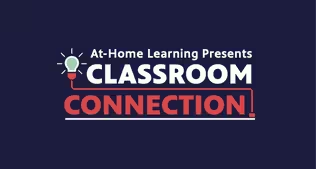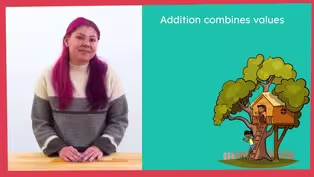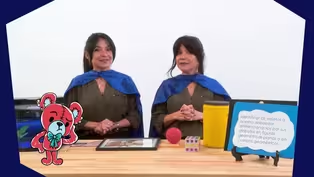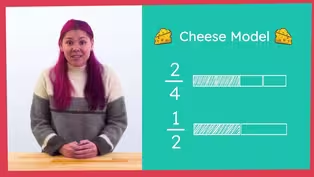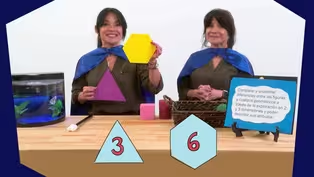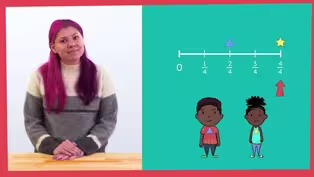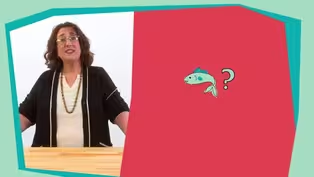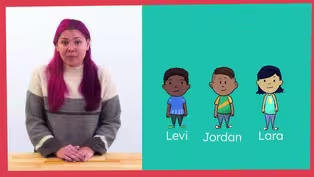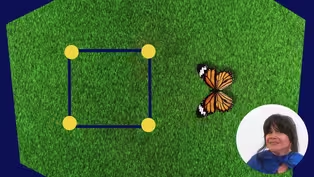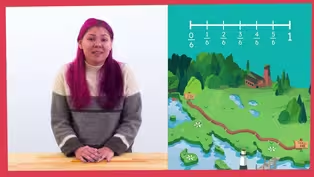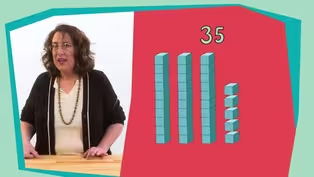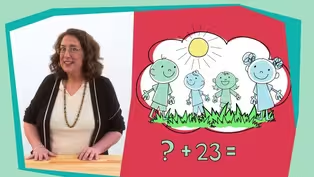
Episode 12 | Math Lessons
3/8/2021 | 28m 46sVideo has Closed Captions
Math lessons for early learners, led by NC teachers.
The first lesson (aimed at 3rd graders) helps students learn strategies for solving equal group problems.The second lesson (aimed at 1st-2nd graders) introduces students to conceptual subitizing. Classroom Connection is your At-Home Learning companion where children love to learn. All lessons are led by NC educators.
Problems playing video? | Closed Captioning Feedback
Problems playing video? | Closed Captioning Feedback
At-Home Learning Presents: Classroom Connection is a local public television program presented by PBS NC

Episode 12 | Math Lessons
3/8/2021 | 28m 46sVideo has Closed Captions
The first lesson (aimed at 3rd graders) helps students learn strategies for solving equal group problems.The second lesson (aimed at 1st-2nd graders) introduces students to conceptual subitizing. Classroom Connection is your At-Home Learning companion where children love to learn. All lessons are led by NC educators.
Problems playing video? | Closed Captioning Feedback
How to Watch At-Home Learning Presents: Classroom Connection
At-Home Learning Presents: Classroom Connection is available to stream on pbs.org and the free PBS App, available on iPhone, Apple TV, Android TV, Android smartphones, Amazon Fire TV, Amazon Fire Tablet, Roku, Samsung Smart TV, and Vizio.
Providing Support for PBS.org
Learn Moreabout PBS online sponsorshipMore from This Collection
Math lessons for early learners, led by NC teachers.
Video has Closed Captions
Math lessons for early learners, led by NC teachers. (28m 46s)
Video has Closed Captions
Math lessons for early learners, led by NC teachers. (28m 46s)
Video has Closed Captions
Math lessons for early learners, led by NC teachers. (28m 46s)
Video has Closed Captions
Math lessons for early learners, led by NC teachers. (28m 46s)
Video has Closed Captions
Math lessons for early learners, led by NC teachers. (28m 46s)
Video has Closed Captions
Math lessons for early learners, led by NC teachers. (28m 46s)
Video has Closed Captions
Math lessons for early learners, led by NC teachers. (28m 46s)
Video has Closed Captions
Math lessons for early learners, led by NC teachers. (28m 46s)
Video has Closed Captions
Math lessons for early learners, led by NC teachers. (28m 45s)
Video has Closed Captions
Math lessons for early learners, led by NC teachers. (28m 46s)
Video has Closed Captions
Math lessons for early learners, led by NC teachers. (28m 45s)
Video has Closed Captions
Math lessons for early learners, led by NC teachers. (28m 46s)
Providing Support for PBS.org
Learn Moreabout PBS online sponsorship[cheerful upbeat music] ♪ - Yo!
Where my super learners at?
It's another great day in the place to learn and play.
And boy, do I have an exciting day for you today!
Look, who's ready, because I know I am.
Why?
Because learning is fun de mental.
So it's time to add a little bit of fun to that mental with today's Classroom Connection.
Y'all ready for some learning?
Let's get it.
- Hello friends.
My name is Diane and I'm ready to explore some math ideas with you.
Today, we're going to continue talking about strategies for solving equal group problems.
You will need a piece of paper and a writing utensil.
While you grab your items, I'll go grab mine.
[upbeat music] - Let's talk about a word that will show up during our time together.
We're going to be talking today about the word factor.
What we want to know is that when we're talking about factors, we're talking specifically about multiplication.
So with that being said, factors, if we're defining them, are two numbers multiplied together.
[gentle upbeat music] A lot of times when we're writing a number sentence, when we're talking about multiplication, you'll see blank times blank.
That looks more like a plus sign so we're gonna make sure that we know that it's multiplication.
These two blanks would be where we put our factors.
So then what do these mean?
It's a great question.
One of them is going to be talking about the number of groups.
[gentle upbeat music] That is going to be 10 packs of pencils or we're going to be talking about three packs of crackers, whatever the case may be, it's that number of groups that we have.
The second factor that we're talking about is going to be the number in each group.
[gentle upbeat music] When we talk about the number in each group, how many pencils were in those packs?
Was it five?
Was it 10?
Whatever the case may be, it's however many are in the group.
The biggest thing when we're talking about factors is that we are going to be looking at equal groups.
So let's look down at my train cars.
You say, Oh, I see three train cars so I've got three groups.
Now what about the number in each group?
What do you notice here?
[gentle upbeat music] Right they're unequal.
That would be an issue if we're trying to figure out a factor because the number in each group is unequal.
[gentle upbeat music] So now looking at this, how are we going to make this equal?
What would you do?
I know for me, I would definitely have one of these people, where there's three in the train car come over here to hang out with this person.
Then I've got two people in this train car, two people in this train car and two people in this train car.
So, my two factors for this are going to be three and two.
Three train cars and two people.
Understanding factors is so important when you're learning about equal groups.
- One way that you may know to solve equal group problems is to skip count.
We could count by twos or tens to figure out how many we have.
Let's see if we can use our counting strategy to think about this problem.
Also remember that we can use drawings, words or numbers to help us think about this problem.
Check it out.
There are three cars in the parking lot, each car has four wheels.
How many wheels are there altogether?
How do you think you could represent this?
I'll give you a minute to think, draw or write.
Now I'm gonna do it on my paper too.
[gentle upbeat music] All right.
So on the count of three, either show me what you wrote or say what you were thinking.
One, two, three.
Those are great ideas.
Some of you used a drawing, others of you wrote number sentences.
And then several of you, what I think you wrote was the solution.
Let's use some of your ideas to solve this together.
One strategy that I saw was counting by ones.
That connects to one of the drawings that I saw too.
I remember that some of you drew three circles to represent the cars and four dots inside to represent the wheels.
It looks like this.
We could count each dot or wheel.
So one, two, three, four, five, six, seven eight, nine, 10, 11, 12.
12 wheels.
What is another way that we could count the car wheels?
Did you say by fours?
Let's try that.
We'll use the same picture as before but this time we won't count each dot separately but in groups of four.
count with me, four, eight 12.
Now, what number sentence could we write for counting by fours?
[gentle upbeat music] Yes, that's right.
We could write four, plus four, plus four equals 12.
Is there a way other than addition to represent and solve this problem?
Hmm.
Let's look back at our work again.
What do you notice?
Talk to a friend or trusted adult about your thinking.
[gentle upbeat music] I noticed that we kept writing four.
This was the number we were counting by, it's also the number of wheels on each car.
I noticed that there are three fours in our number sentence.
I wonder how that can help us write a number sentence that uses multiplication.
So blank times blank equals blank.
Remember that the factors or numbers that we multiply tell us one, the number of groups and the number in each group.
The product or the answer tells us the total amount.
Do you have an idea?
I think I heard it.
Someone said three times four equals 12.
Now the question is what does the three represent in our number sentence?
You say that one more time?
Yeah.
The number of groups or the number of times we counted by fours.
Now what about that four, what does it represent?
One more time, little bit louder y'all.
You got it.
The number of items in each group.
So how many total wheels do we have?
Say it loud, say it proud.
That's right, it's 12 wheels.
You got it.
Let's try another one.
There are six minivans in the school carpool line.
Each minivan has enough seats for five people.
How many people will the six vans hold altogether?
First, let's think about what's happening in our story.
Would you tell that to me?
[gentle upbeat music] Right.
There are six minivans that will hold five people.
But what are we trying to find out?
The number of minivans?
Or are we looking at the number of people in the minivans?
Right.
The question says, how many people will the six vans hold altogether?
So it looks like we are counting the total number of people in the six vans.
Give you a few moments to try this one on your own paper.
You can use pictures, numbers or words to explain your thinking.
Hmm.
Let's try this out.
[gentle upbeat music] - Hmm.
Are you ready?
All right, let's go.
Can you show me your thinking?
Oh, wow!
That's some really great work.
Let me see if I can share how you solved.
I saw that some of you used a picture like we did for the wheel problem.
Six bigger circles and five dots inside them.
Now let's use a repeated addition equation to show that we can count by fives.
So we have five, plus five, plus five, plus five, plus five plus five.
How can we represent that with a multiplication equation?
Remember the factors or numbers that we multiply show the number of groups, times the number in each group.
So blank times blank equals blank.
What are our factors?
One more time?
Nice and loud.
Right?
Six and five.
Remind me again, what does the six represent?
Yes.
The vans or a number of groups.
What about the five?
Exactly.
Yeah.
The number of people in each van.
So what is our answer?
Did you say 30?
How do you know?
Okay, so you counted by fives, that's a very good strategy.
Let's double check, let's count together.
Five, 10, 15, 20, 25, 30.
Great work mathematicians.
Today we explored different ways to represent and solve problems with equal groups or multiplication.
We use pictures, number sentences and counting strategies in our solutions.
Great job.
This week, be on the lookout for times when you could use multiplication and try out your strategies.
Till next time, bye y'all.
- Wow!
My head feels full of numbers and letters.
What's the best way to organize all that amazing info?
Let's listen to some music.
- Let's get our repertoire of sounds.
I'm gonna create a sound, and I want you to use your beautiful imaginations to tell me what it makes you think of.
And guess what?
There can be no wrong answers.
Okay.
Let's get started.
[singing muffled melody] What do you think?
- That sounded like a conversation between two people, going back and forth.
- Back and forth, back and forth.
What about you, John, can you do a conversation between two people back and forth?
[double bass playing] [laughing] I love it.
I love it.
Now you guys can try.
Let's try one more.
[singing muffled melody] What do you think?
- For me, that sounded like someone was walking away.
[sighs] The sounds got more softer and softer as they got farther away.
- You're a genius, Caleb, you are a genius.
- Thanks Miss Nina, I can see what I did.
[laughing] - Let me hear you walk away, John.
[double bass playing] There he goes.
- And he's gone.
- And he's gone.
And he's gone.
You have within your power to create any shapes, using any sounds that you choose.
They belong to you, they're your creation, they come from silence and they disappear into silence but they're energy and they're your energy.
- Did y'all like that?
That was so cool.
Thank goodness for this time right at home.
Look, can't stop now, check out what we got next.
- Hi friends?
My name is Dawn and I am so happy to be here with you today.
This is my friend Splat and he is going to help me today with some math fun.
We call him Splat because he loves to chew bubble gum but sometimes he makes a mess with it.
[bubble gum popping] He and I are so excited to do some fun math with you.
Before we get started, you might want to gather some supplies.
Maybe you can find an adult or a stuffed animal to share your thinking with.
Or you might want to also get some beans or some pasta to sort into groups.
Finally, you might want to get a notebook, paper or a journal so that we can start a math journal together.
I'll give you some time to go and find these things to use with our math lesson today.
[gentle upbeat music] Let's get started.
Splat and I are going to show you some dots very quickly on my screen.
This is called subitizing.
Can you say that with me?
Subitizing.
Your job is to say or show with your beans or pasta, how many dots you see with each picture I show on the screen.
Then, you will explain how you know how many dots there are to a trusted adult or even a stuffed animal or you could make the image with your beans or pasta.
Okay.
Splat has our first image ready.
Watch the screen.
[gentle upbeat music] [dots popping] Whoa, that was super quick.
How many blue dots did you see?
[gentle upbeat music] Talk to a friend and tell them how many dots you saw or you can make it with your beans or pasta.
[gentle upbeat music] That's right, they are three.
Now, will you whisper to Splat how you saw those dots?
[gentle upbeat music] Oh wow!
I heard you say you saw a group of two dots and one dot.
Okay Splat, I think they are ready for another one image.
[gentle upbeat music] [bubble gum popping] Oh no!
Splat blew a bubble and some of his bubble gum covered part of our image.
How many dots do you think are under Splat's gum?
Tell an adult or even a stuffed animal how you know how many dots are under his gum.
[gentle upbeat music] Hey, Splat, let's clean up this gum to see how many dots there are.
[gentle upbeat music] That's right!
There are two dots underneath Splat's gum.
Tell a trusted adult or stuffed animal something you learned from this picture about how to make three.
[gentle upbeat music] That's right.
I learned also that two dots and one dot can combine to make three dots.
That's correct, because we know that two plus one equals three.
It looks like Splat has cleaned up his gum and he has more dots ready for us.
Are you ready?
Watch the screen.
[gentle upbeat music] [dots popping] Whisper to me how many blue dots you saw.
[gentle upbeat music] That's good thinking.
That's right.
There are four dots.
How did you see them?
Will you talk to a friend or stuffed animal or make the dots with your beans and pasta?
[gentle upbeat music] [electronic buzzing] What's that Splat?
Oh, Splat says that he saw it as two dots on the top and two dots on the bottom.
Is that what you saw too?
That is great thinking.
Splat, I'll get our next image ready this time.
Make sure that you do not, [bubble gum popping] [gentle upbeat music] Oh, no!
Splat's done it again.
His bubblegum is covering up some of our dots.
Can you help me figure out how many dots are under Splats gum?
Talk to an adult or stuffed animal about how you know or show how you know, using your beans or pasta.
[gentle upbeat music] I can tell you are really thinking hard about how to make four.
[gentle upbeat music] Do you think there is another way to figure out how many dots are under Splat's gum?
If so, whisper it to yourself or use your beans or pasta to help you.
Okay.
Let's clean up this gum to see how many dots there are.
[gentle upbeat music] There were two dots under Splat's gum.
What can we learn from this picture about how to make four dots?
Talk to a friend or stuffed animal about your thinking.
[gentle upbeat music] One thing I learned is that two and two make four.
How many other ways can we make four?
Whisper to yourself as Splat and I get this gum cleaned up?
Did you think about three and one?
Yes, because three plus one equals four and also zero plus four equals four.
You are really thinking hard about all the ways to make four.
That is super great work.
Okay Splat, let's show our next image.
Are you ready to help me figure out how many dots there are?
Great.
Here it is is, see if you can use what you learned in the last image to help you know, how many dots there are.
[dots popping] [gentle upbeat music] How many blue dots did you see?
Talk to a trusted adult or stuffed animal about how many dots you saw.
[gentle upbeat music] That's right.
They are five.
How did you see those dots?
Can you tell an adult or friend how you saw those dots or can you make the dots with your pasta or beans?
[gentle upbeat music] I saw three and two, but I wonder if you see it differently.
Can you whisper to yourself another way to make five?
[gentle upbeat music] You are right.
You can make five as four plus one.
You can also make five with zero plus five.
[bubble gum popping] [gentle upbeat music] Oh, Splat.
I'm beginning to think you are covering our dots with gum on purpose.
All right.
I need your help one more time.
How many dots are under Splat's gum?
[gentle upbeat music] Three, that's correct.
Great job.
Tell a friend how you know there are three dots under his gum.
[gentle upbeat music] Yes.
There are three dots under his gum because we had five and then we only had two, and five minus three equals two.
Okay Splat, one last time.
Let's clean up this gum to see how many dots there are.
[gentle upbeat music] Tell a trusted adult or stuffed animal something we can learn from this picture.
[gentle upbeat music] Splat said that he learned that three dots and two dots can combine to make five dots.
Do you agree?
I do too.
Friends, I have one more image to show you.
This one will be a little bit different.
Are you ready?
[dots popping] [gentle upbeat music] Wow!
Did you see that five frame?
Now our dots are organized.
Splat can't cover up that picture.
We can see that all the squares are full of dots and it's a five.
That makes it so easy to count.
When we see this five frame all full, we know we can just start counting at five.
That makes it so much easier.
Friends, Splat and I would love to hear about what you learned today.
I have these sentence starters and I'm hoping you can finish these sentences with me.
They say, today in math I learned, and I can.
So if I were doing it, I might say, today in math I learned how to subitize.
I can see numbers quickly and tell how many are missing.
Now it's your turn.
[gentle upbeat music] [dots popping] Read this with me and finish it by telling an adult or stuffed animal, today in math I learned... [gentle upbeat music] Now let's read our next sentence and you can finish it.
I can... [gentle upbeat music] You are doing a great job talking about your math learning.
You can also write this on paper or in your notebook and start a math journal.
Splat and I have to be going now.
We had fun subitizing with you today.
Remember, that subitizing is instantly seeing a group of objects, such as dots.
You really thought hard about how to figure out how many dots there were each time.
When you figured out how many dots were under Splat's gum, you use subitizing to help you think about parts and wholes.
Recognizing and combining groups of dots can help us name a total and different ways to make that total.
Splat and I hope you enjoy today and we hope to see you soon.
- I have some very good news for you.
This next video is gonna really make you smile.
Let's check it out.
Hi everyone, I'm Ms. Raven, and today we are going to get active.
I want you guys to join me by moving your arms from side to side, [bright hiphop music] [shoes squeaking] we're just gonna swing them here and every time I swing my toe is stepping.
[bright hiphop music] [shoes squeaking] Good job and we'll lift them up.
[bright hiphop music] [shoes squeaking] And back to our center.
[bright hiphop music] [shoes squeaking] And this time we're just gonna craw our biceps in.
[bright hiphop music] [shoes squeaking] And back to center.
[bright hiphop music] [shoes squeaking] You're doing great.
We're gonna come up this time.
Here we go, and up.
[bright hiphop music] [shoes squeaking] And back to center.
[bright hiphop music] [shoes squeaking] Good and biceps.
[bright hiphop music] [shoes squeaking] Great job and thank you for joining me today, I will see you next time.
- Well, that's all the time we have for today.
I can't wait to see you next time.
In the meantime, be kind to each other, wishing you peace, love and learning.
[cheerful upbeat music] ♪


- Home and How To

Hit the road in a classic car for a tour through Great Britain with two antiques experts.












Support for PBS provided by:
At-Home Learning Presents: Classroom Connection is a local public television program presented by PBS NC
